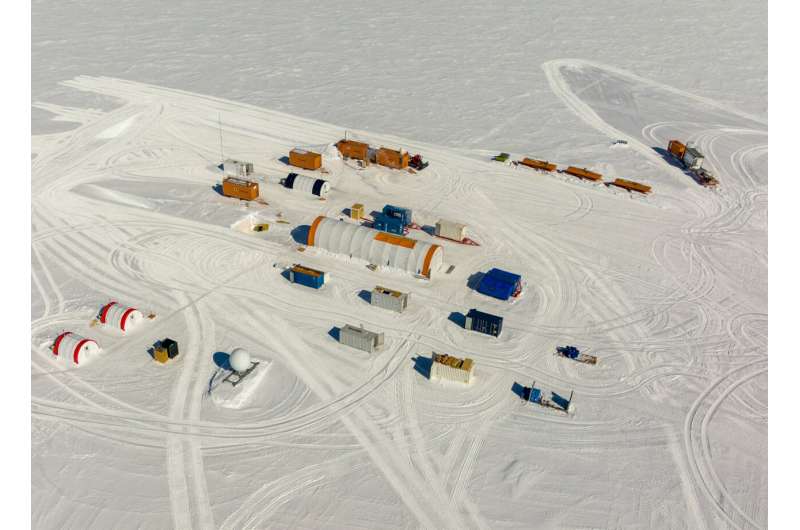
The oldest ice in the world is being drilled for here as part of the European “Beyond EPICA – Oldest Ice” project: the camp at Little Dome C in Antarctica. Credit: PNRA/IPEV
Ice cores are a unique climate archive. Thanks to a new method developed by researchers at the University of Bern and Empa, greenhouse gas concentrations in 1.5 million year old ice can be measured even more accurately. The EU project “Beyond EPICA” with the participation of the University of Bern aims to recover such old ice in Antarctica.
The search for the oldest ice on Earth has taken an important step forward. The Beyond EPICA—Oldest Ice project, a European consortium that includes the University of Bern, completed its second field season at the end of January. The drilling reached a depth of 808 meters. The project objective is to look back 1.5 million years into the past and obtain data on the development of temperature, the composition of the atmosphere and the carbon cycle.
A depth of around 2700 meters must be reached in the Antarctic ice sheet and an ice core recovered. If everything goes as planned, this should be the case in 2025. Only then will the complex analysis of the oldest ice in this core follow, which new methods are currently being developed for.
The University of Bern plays a crucial role in the development of the new analysis technologies. The team led by Hubertus Fischer, professor of experimental climate physics and member of the Oeschger Center for Climate Change Research has succeeded, in collaboration with Empa, in developing a new technique to jointly measure the greenhouse gases carbon dioxide (CO2), methane (CH4) and nitrous oxide (N2O) as well as the carbon isotope composition of CO2.
The ice sample needed for this is with a thickness of just one centimeter very small, yet the highest accuracy is possible in the measurement.
“These are important prerequisites,” explains Hubertus Fischer, “for obtaining high-precision, high-resolution records from the oldest ice in Beyond EPICA.” In the 1.5 million year old ice, 15,000 to 20,000 years of climate history are compressed into just one meter of ice core, which places completely new demands on ice core analyzes. Ice cores are an extremely important climate archive because only they contain the air of the past to directly measure past greenhouse gas concentrations.
2023-03-05 13:00:03
Article from phys.org
Improved Technique Enhances Precision of Analyzing Ancient Ice
Scientists have long been using ancient ice as a natural archive of atmospheric gases, dust, and other climate indicators. The analysis of these samples has revealed valuable information about Earth’s past climate and environmental conditions, helping us better understand today’s global changes. However, analyzing ancient ice has been challenging due to its limited availability and sensitivity to contamination. Now, a team of scientists has developed a new technique that enhances the precision and accuracy of ancient ice analysis, opening new doors for research and discoveries.
In a recent study published in the journal Nature, researchers from the University of Bern and the University of Copenhagen have demonstrated the potential of the new technique for analyzing ancient ice samples from deep ice cores. The technique, known as “continuous flow analysis with laser-induced fluorescence detection” (CFA-LIF), allows for the measurement of multiple chemical and physical parameters of the ice samples simultaneously, with high resolution and minimal contamination risks.
One of the major advantages of the CFA-LIF technique is its ability to detect and measure microscale impurities and particles in the ice sample. These impurities can provide valuable information about the atmospheric and environmental conditions at the time the ice formed. For example, the researchers were able to detect and quantify mineral dust, sea salt, and volcanic ash particles in the ancient ice samples, revealing information about past volcanic eruptions and oceanic currents.
Moreover, the CFA-LIF technique can also determine the stable isotopic composition of the ice sample, which is a crucial parameter for reconstructing past climate and environmental changes. The researchers were able to measure the isotopic ratio of hydrogen and oxygen in the ice samples with unprecedented precision, which provides insights into past temperatures and precipitation patterns.
The new technique can also analyze other chemical and physical properties of the ice samples, including organic compounds, acidity, and electrical conductivity. This multi-parametric approach allows for a more comprehensive and accurate understanding of past environmental conditions and their interconnections.
In conclusion, the CFA-LIF technique marks a significant advancement in the field of ancient ice analysis, providing an unprecedented level of precision, resolution, and sensitivity. The technique opens new avenues for scientific investigations on Earth’s past climate and environmental evolution, with potential implications for future climate projections and policy-making. The findings of this study highlight the critical importance of developing innovative and robust analytical tools for tackling complex environmental challenges.
